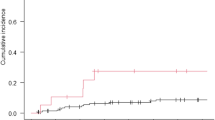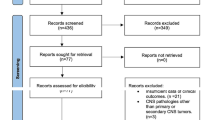Abstract
Background
To determine the current practice of stereotactic irradiation (STI) for brain metastases in Japan by a questionnaire survey.
Methods
A questionnaire was distributed to 313 institutions performing STI with one of the following machines: Gamma Knife (GK), CyberKnife (CK), Novalis (Nov), or other linear accelerator (LINAC)-based systems (OLS). The participation was voluntary.
Results
There were 163 responding institutions. The total number of STI treatments between April 2013 and March 2014 was 10,684. Stereotactic radiosurgery (SRS) and fractionated stereotactic radiotherapy (SRT) were performed in 8624 (80.7%) and 2060 (19.3%) cases, respectively. Whole-brain radiation therapy (WBRT) was performed for a total of 3515 cases. For a case model of a 1.5-cm solitary brain metastasis in a non-eloquent area, the most common GTV-PTV margin was 2 mm (22 of 114 institutions), and an institutional standard fraction was 1 (75 of 114 institutions). The doses for the model case also varied from 13.0 to 26.0 Gy (Median 20 Gy) when converted to SRS (α/β = 10). A prescription point was at the PTV margin the most. The median dose constraints which were converted to SRS (α/β = 3) to organs at risk were 12.2, 12.7, and 13.7 Gy for optic nerves, cavernous sinus, and brainstem, respectively.
Conclusions
STI for brain metastases in current practice varied significantly among institutions. These different strategies relied mostly on the type of treatment machine used. It is thus necessary to establish a common guideline to express dose prescriptions and plan qualities for different STI machines.
Similar content being viewed by others
References
Barnholtz-Sloan JS, Sloan AE, Davis FG et al (2004) Incidence proportions of brain metastases in patients diagnosed (1973 to 2001) in the metropolitan detroit cancer surveillance system. J Clin Oncol 22(14):2865–2872
Soffietti R, Ruda R, Mutani R (2002) Management of brain metastases. J Neurol 249(10):1357–1369
Schouten LJ, Rutten J, Huveneers et al (2002) Incidence of brain metastases in a cohort of patients with carcinoma of the breast, colon, kidney, and lung and melanoma. Cancer 94(10):2698–2705
Arita H, Narita Y, Miyakita Y et al (2014) Risk factors for early death after surgery in patients with brain metastases: reevaluation of the indications for and role of surgery. J Neurooncol 116(1):145–152
Zimm S, Wampler GL, Stablein D et al (1981) Intracerebral metastases in solid-tumor patients: natural history and results of treatment. Cancer 48(2):384–394
Patchell RA, Tibbs PA, Regine WF et al (1998) Postoperative radiotherapy in the treatment of single metastases to the brain: a randomized trial. JAMA 280(17):1485–1489
Waki F, Ando M, Takashima A et al (2009) Prognostic factors and clinical outcomes in patients with leptomeningeal metastasis from solid tumors. J Neurooncol 93(2):205–212
Patchell RA (2003) The management of brain metastases. Cancer Treat Rev 29(6):533–540
Kondziolka D, Patel A, Lunsford LD et al (1999) Stereotactic radiosurgery plus whole brain radiotherapy versus radiotherapy alone for patients with multiple brain metastases. Int J Radiat Oncol Biol Phys 45(2):427–434
DeAngelis LM, Delattre JY, Posner JB (1989) Radiation-induced dementia in patients cured of brain metastases. Neurology 39(6):789–796
Sahgal AD, Larson D, Knisely J (2015) Stereotactic radiosurgery alone for brain metastases. Lancet Oncol 16(3):249–250
Sahgal A, Aoyama H, Kocher M et al (2015) Phase 3 trials of stereotactic radiosurgery with or without whole-brain radiation therapy for 1 to 4 brain metastases: individual patient data meta-analysis. Int J Radiat Oncol Biol Phys 91(4):710–717
Tanaka K, Kawaguchi G, Abe E et al (2013) Questionnaire survey regarding radiation therapy of metastatic brain tumors: results from the north japan radiation oncology study group. Stereotact Radiother 17:109–119 (in Japanese)
Minniti G, Scaringi C, Paolini S et al (2016) Single-fraction versus multifraction (3 × 9 Gy) stereotactic radiosurgery for large (> 2 cm) brain metastases: a comparative analysis of local control and risk of radiation-induced brain necrosis. Int J Radiat Oncol Biol Phys 95(4):1142–1148
Naoi Y, Akamatsu M, Ito K et al (2003) Aspect of dose prescription for stereotactic radiosurgery: the survey by questionnaire report of 2001st And 2002nd JASTRO theme study. J Jpn Soc Ther Radiol Oncol 15:297–306 [in Japanese].
Timmerman RD (2008) An overview of hypofractionation and introduction to this issue of seminars in radiation oncology. Semin Radiat Oncol 18(4):215–222
Aoyama H (2018) Low-dose whole brain radiation therapy combined with stereotactic radiosurgery for brain metastases: multi-institutional phase II study (JROSG 13–1). https://upload.umin.ac.jp/cgi-open-bin/ctr/ctr_view.cgi?recptno=R000010628. Accessed 2 July 2018
Acknowledgements
This study was supported in part by JSPS KAKENHI Grants (no. 16K10410 to HI and no. 15H04903 to HA). Members of JROSG Working Subgroup for Neurological Tumors on this manuscript are Ken Harada, Hiroshi Igaki, Ariga Takuro, Nobuyuki Hayashi, Ayae Kanemoto, Takufumi Komiyama, Yasuo Matsumoto, Toshimichi Nakano, Rikiya Onimaru, Hirotake Saito, Minako Sumi, Masao Tago, Katsuya Maebayashi, Hidefumi Aoyama.
Author information
Authors and Affiliations
Consortia
Corresponding author
Ethics declarations
Conflict of interest
The authors declare that they have no conflict of interest.
Appendix
Appendix



About this article
Cite this article
Harada, K., Igaki, H., Abe, E. et al. Present clinical practices of stereotactic irradiation for metastatic brain tumors in Japan: results of questionnaire survey of the Japanese Radiation Oncology Study Group (JROSG) working subgroup for neurological tumors. Int J Clin Oncol 23, 1015–1022 (2018). https://doi.org/10.1007/s10147-018-1313-4
Received:
Accepted:
Published:
Issue Date:
DOI: https://doi.org/10.1007/s10147-018-1313-4




